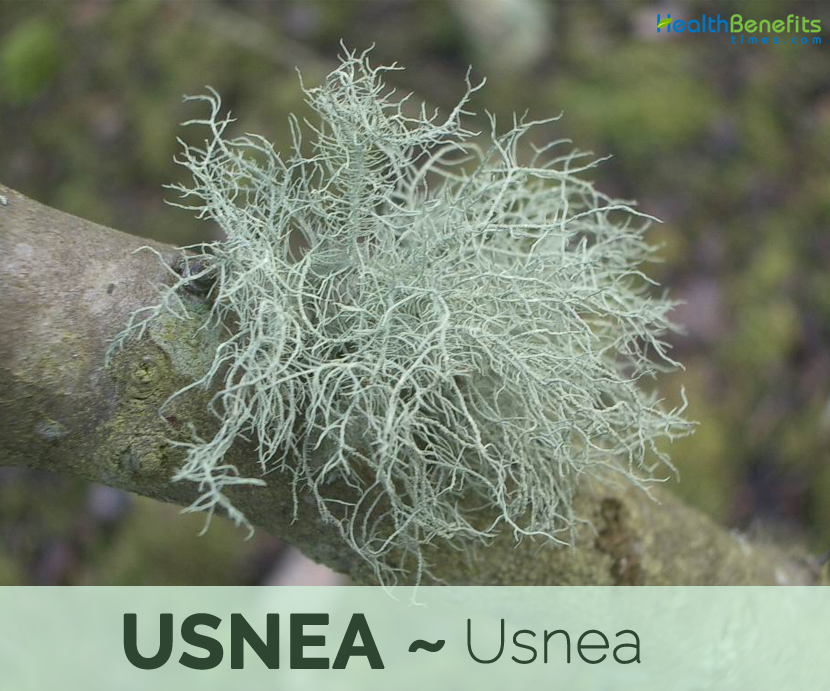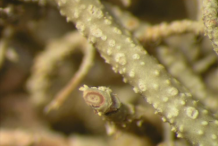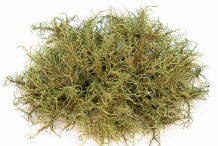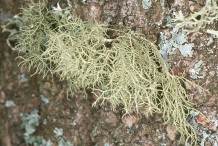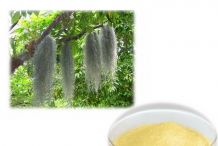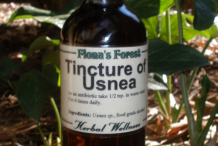Plant
Usnea is slow growing lichen about 3 cm tall. It is found growing all over the temperate zones in the northern hemisphere, particularly in the coastal rainforest and sub-arctic regions. It usually grows on tree branches and prefers moist habitats. It is the green tangly mass that hangs down from the dead trunks and branches of trees, especially pine trees. Usneas have a double filament, with an inner core of white to yellow, and an outer portion that is green to grey; the green is contributed by the algae’s chlorophyll. Usnea may be whitish, reddish, or black. The plant body of usnea is used to make medicine. They are bright red and yellow, and grow on rocks. They are long wispy strands of gray-green hair, hanging like beards from hardwood trees in rainy forests. Or they are floppy and leaf-like.
Health benefits of Usnea
Usnea is a type of lichen that grows on trees. Though lichens appear to be single plants, they are really a combination of fungus and algae that grow together for their mutual benefit. Lichens grow in colorful, flat patches. Usnea may be whitish, reddish, or black. The plant body of usnea is used to make medicine. For years now, Usnea has proven to have quite a number of medical uses. Some of the medical uses of Usnea include:
1. Antibacterial benefits
Usnea is popular for its antibacterial properties. Research has discovered that the lichen kills bacteria particularly the bacteria that are found in the digestive tract. Further studies reveal that it is in fact extremely beneficial to humans as it does not kill all kinds of bacteria and may leave the bacteria that are useful to the digestive tract unharmed. Usnea can be used to efficiently cure several conditions caused by gram positive bacteria. Some of the bacteria that it acts against effectively include Staph (Staphylococcus simulans and S. Aureus). It also acts against Streptococcus. By only killing the gram positive bacteria, it is a great way of eliminating bacteria without harming the beneficial bacteria.
2. Antiviral benefits
As we all know that viruses are microscopic and live within the cells, they are pretty hard to get rid of once they attack. This is another medical benefit of Usnea. Regularly taking the herb helps in clearing the body of a wide range of viruses. It helps to clears viruses from the bronchial area and the lungs.
3. Anti fungal benefits
Usnea is quite beneficial in clearing antifungal infections. Usnea has been researched to effectively cure several types of fungal infections, Candida species included. For its antifungal uses, the herb can be used both internally and topically, depending on how it is available and how it is favored.
4. Healing Wounds
Usnea is a fantastic choice for wounds. As we’ve seen, it is a powerful antimicrobial herb. Using usnea herb in wounds can help treat or prevent infection. It also has wound-healing abilities that can accelerate the healing process. To use usnea on a wound you might try it as a powdered herb or, if the wound is not infected, as a salve.
Other Traditional uses and benefits of Usnea
- It is good for sore throats and skin infections.
- It is also effective against a bacterium that usually causes pneumonia.
- Due to its bitter taste, usnea encourages digestion and was historically used by herbalists to treat indigestion.
- It was also reportedly used over 3,000 years ago in ancient Egypt, Greece, and China to treat unspecified infections.
- Usnea is a wonderful remedy for cellulitis or infected wounds.
- It is used in the treatment of bronchitis and as part of herbal cancer therapy, particularly for cases of thyroid cancers in China.
- It is used to heal respiratory and sinus infections, pneumonia, profuse phlegm, strep throat, colds, flus, as well as, urinary tract, kidney, and bladder infections.
- It has been used traditionally for treating headaches, ocular irritation, malaria, scorfula, leucorrhea, bleeding, carbuncle and toxic snake bite.
- It is beneficial for people with chronic fatigue syndrome, HIV, herpes, and other chronic conditions related with depressed immunity.
- This herb can be used to heal lung illnesses such as Bronchitis, wet or dry coughs, or other upper respiratory problems.
- Topically, it can be used to heal numerous infections.
- It is beneficial for women with yeast infections trichonomosas, bacterial vaginosis, and chlamydia, and is used to treat other fungal infections like athlete’s foot and infected wounds.
- To use topically, mix one part Usnea with five parts of heavy stock cream or jelly to make an antibacterial cream.
Other Facts
- Usnea species have been used to create orange, yellow, green, blue and purple dyes for textiles.
- Usnea barbata has been used in cosmetic production for its antimicrobial and antifungal properties as a preservative and deodorant.
- It can be used in mouthwashes, gargles and lozenges, for inflammation of the oral mucus membranes.
- City trees rarely have usnea because it is very sensitive to air pollution.
- Because of the absorbent quality of usnea, it has been used in baby diapers, wound dressings, and feminine napkins.
Culinary Uses
- Inland Dena’ina Natives of Alaska occasionally eat Usnea as an emergency food or camp food after first boiling it in water.
Dosages
Usnea is commercially available in bulk form or as a powder, capsule, or tincture.
The tincture must be diluted in water before ingesting or using externally. Usnea tincture may be taken every two hours to treat bacterial infections. Other sources recommend taking 3-4 ml of tincture three times daily.
An usnea tea can be prepared by steeping 2-3 tsp of dried lichen or 1-2 tsp of powdered lichen in 1 cup of boiling-hot water. The tea may be taken three times a day.
In the capsule form, the patient should take 100 mg of usnea three times a day.
Usnea is used externally to treat fungal infections and skin ulcers. It can also be used as a douche to treat cystitis, urinary tract infections, and vaginal infections. Usnea is generally used as a vaginal suppository to treat mild cervical dysplasia. It is taken by mouth to treat colds, strep throat, influenza, sore throats, respiratory infections, and gastrointestinal disorders.
Types
There are about 86 species of Usnea.
- Usnea arizonica
- Usnea articulata
- Usnea australis
- Usnea baileyi
- Usnea californica
- Usnea capillaris
- Usnea catenulata
- Usnea cavernosa
- Usnea ceratina
- Usnea ciliifera
- Usnea cirrosa
- Usnea condensata
- Usnea confusa
- Usnea cornuta
- Usnea deformis
- Usnea dimorpha
- Usnea diplotypus
- Usnea duriuscula
- Usnea endochrysea
- Usnea erinacea
- Usnea evansii
- Usnea fibrillosa
- Usnea filipendula
- Usnea finkii
- Usnea florida
- Usnea fragilescens
- Usnea freyi
- Usnea fulvoreagens
- Usnea furfurosula
- Usnea glabrata
- Usnea glabrescens
- Usnea graciosa
- Usnea hesperina
- Usnea hirta
- Usnea intermedia
- Usnea kajalae
- Usnea lapponica
- Usnea leucosticta
- Usnea longissima
- Usnea merrillii
- Usnea michauxii
- Usnea mirabilis
- Usnea monstruosa
- Usnea montana
- Usnea mutabilis
- Usnea occidentalis
- Usnea pachyclada
- Usnea pensylvanica
- Usnea perplexans
- Usnea prostrata
- Usnea ramillosa
- Usnea retifera
- Usnea roseola
- Usnea rubicunda
- Usnea sacbiosa
- Usnea scabrata
- Usnea scholanderi
- Usnea sphacelata
- Usnea spinulifera
- Usnea strigosa
- Usnea stuppea
- Usnea subclavata
- Usnea subfloridana
- Usnea subfusca
- Usnea subhirta
- Usnea sublaxa
- Usnea subscabrosa
- Usnea substerilis
- Usnea sylvatica
- Usnea trichodea
- Usnea tristis
- Usnea vainioi
- Usnea variegata
- Usnea variolosa
- Usnea wirthii
- Usnea xanthopoga
Precautions
- It should not be used for more than three weeks.
- Avoid during Pregnancy and breast feeding.
- It may cause Gastrointestinal Disorders.
- It is recommended that you use it cautiously while applying the herb to the skin directly.
- Direct application of the herb on the skin may result in allergic contact dermatitis.
- Usnea contains some chemicals that might harm the liver. If you have liver disease, don’t take usnea by mouth.
References:
https://www.itis.gov/servlet/SingleRpt/SingleRpt?search_topic=TSN&search_value=190765#null
http://www.uofmhealth.org/health-library/hn-2177002
http://www.itmonline.org/arts/usnea.htm
http://www.encyclopedia.com/plants-and-animals/plants/plants/usnea
https://plants.usda.gov/core/profile?symbol=USNEA2
Comments
comments
| Usnea Quick Facts | |
|---|---|
| Name: | Usnea |
| Scientific Name: | Usnea |
| Origin | North America |
| Colors | Light green, grey or yellowish in color |
| Shapes | Thready filaments that resemble coarse hair, stretchy like elastic if you tug gently on its strands |
| Taste | Bitter |
| Health benefits | Healing wounds and Antibacterial benefits |
